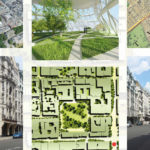「CITY OF TOMORROW 」Architectural Student Competition
類型:學生競賽
主辦機構:Debbie Flevotomou Architects Ltd.
報名截止日期:2月8日
提交截止時間:2月22日12:00
地點:倫敦聖詹姆斯,梅菲爾
獎金:1000英鎊
設計比賽向全世界建築學生開放,旨在實現零碳排放的政府目標,提高對可持續性智慧城市的認識。
基地位於聖詹姆斯東緣,主辦方希望設計能夠結合傳統肌理,形成一個作為保護區的智慧城市。Debbie Flevotomou建築師事務所的Marina Zouni說:“學生競賽是這個項目的第一階段。在第二階段,我們將與商業夥伴和理事會接觸,籌劃項目落地。我們希望該設計能夠成為倫敦及其他城市未來應用的計來源。” 為此,Debbie Flevotomou 建築師事務所將於2月份舉行為期兩週的競賽,獲獎名單將於3月公佈。入選的參賽作品將進入項目的第二階段。

Architectural Student Competition
Registration Opens 1st February 2021 – https://www.debbieflevotomou.com/competition
Brief:
Design a new Node* Pavilion!
* According to Lynchian Analysis a Node is a connection point. Read more in the relevant section.
The pavilion we ask you to design is a key feature for the City of Tomorrow.

Brief Overview:
This should be an one-storey pavilion; the site dimensions are 8.9m X 12m; the pavilion should have an innovative THINK NATURE form inspired by the English Rose.
The design should consider the following functions and try to incorporate as many as possible:
- Electric cars’ charging stations
- Internet connectivity points ( e.g. Antennas, WIFI, Ports etc. )
- Transportation links ( e.g. Bike ports, Car Healing, Scooters etc. )
- Goods delivery ports ( e.g. Lockers, drone drop off points etc. )
- Exhibition space open to the public ( e.g. virtual exhibition, 3D experiences, live cams to nature etc. )

Timetable
Competition Opens for registration: Monday 1st February 2021
Deadline for questions: Monday 8th February 2021
Deadline for submission: Monday 22nd February 2021
Winner Announced: March 2021
Winning Entry Published: March 2021
Exhibition in Mayfair of short-listed entries: June – July 2021
Register at: https://www.debbieflevotomou.com/competition

Submission requirements
The CAD plan and Site Photos will be sent to you via email upon registration.
There are four elements to the design submission. Applicants should refer to the anonymity requirements and submit the following material digitally.

Judging panel
The Judging Panel is expected to comprise:
– Debbie Flevotomou Architects Director – Debbie Flevotomou
– Grosvenor Development Director, Piers Townley
– TLT Solicitor Sustainability Ambassador, Maria Connolly
– Mayfair Business Association Manager, Jer O’ Mahony
– First Base Development Director, Doug Higgins
– Ion Development Board member, Olivier Duquenne
– Wetherell, Mayfair Estate Agents, Peter Wetherell

Finalists and Winning Entry
The three finalists will be featured in the local magazine for Mayfair members and business.
The winning entry will be awarded £1000.
The entry fee is £20 + VAT for individual entries, £40 + VAT for team entries.
The second stage of the project aims to have the design build at some location subject to stakeholders buying in. The winner ( individual or team ) will be involved all the way.
Register at: https://www.debbieflevotomou.com/competition

Eligibility
The competition is open internationally to architectural students of any level. Only one entry per registration.

Call to action
Register at: https://www.debbieflevotomou.com/competition
Upon registration you will receive a CAD Plan and Site photos.
Deadline for questions is the 8th of February 2021.
Deadline for submissions is the 22nd of February 2021.
The concept of the City of Tomorrow
Most “City of Tomorrow” concepts we’ve seen so far have been developed on a white canvas, some on areas of desert, others on reclaimed land, others on brownfield sites. This obviously allows a degree of freedom to incorporate all aspects of sustainability, infrastructure and services, without encountering the constrains that an existing city fabric would impose.
whilst the results of white canvas cities of tomorrow are inspirational and demonstrate well “the art of the possible”, the evolution of existing cities will need a different approach, one that respects local heritage and current norms commercial, residential and civic. In other words, to convert an existing city, there is a great deal of compromise that needs to be applied to thinking outside the box. Nevertheless, the city of tomorrow is a reality that we must strive towards if our national targets for decarbonisation are to be achieved.
In an effort to find an approach that can be adopted by cities around the UK, we are developing a masterplan for our local area.
St. James Mayfair is a good example of a locality with many and diverse constraints. As a conservation area with numerous listed building and limited space for new developments, it offers a great case study for challenging the status quo to deliver the city of tomorrow.
Areas of exploration:
– Road Usage
– Green vehicles vs conventional cars
– Necessary infrastructure
– Decarbonise buildings and energy generators
– Infrastructure for sustainable transportation, green energy generation and distribution, telecommunications, connectivity and data management.
What is a Node & Lynchian Analysis
According to the traditional urban design Lynchian analysis, a city consists of its edges, its nodes, its districts, its paths and its landmarks. Of those, edges are usually set elements defining the city boundaries and hence would not be changed. However, paths, districts and landmarks and nodes can be modernised to become smart-elements of the city; the city can be further enhanced by the introduction of a smart-promenade.
According to the traditional urban design Lynchian analysis, a city consists of its edges, its nodes, its districts, its paths and its landmarks. Of those, edges are usually set elements defining the city boundaries and hence would not be changed. However, paths, districts and landmarks and nodes can be modernised to become smart-elements of the city; the city can be further enhanced by the introduction of a smart-promenade.
Paths
The term “paths” includes road, pedestrian areas and footpaths. As the city of tomorrow will have clean air and a very low carbon foot-print, all transportation within the city must be electrified or based on a different zero tailpipe emissions propulsion. Returning to our local example at Mayfair, roads should evolve, making the most of the area’s character and history, whilst at the same time creating bespoke spaces for each category of road users.
· Some of the roads previously used by automobiles, would be redesigned and repurposed for pedestrians to walk, run, etc. on landscaped routes dedicated for such use.
· Cyclists would need their own dedicated routes; these can be part of the main streets of partial use of pedestrian routes
· In our example, utilities, services, public transport and private transportation would share the main routes. Different approaches can be adopted where larger streets and high-speed roads are available.
Districts
Our example area is a single district protected by conservation orders. As such converting buildings to zero carbon emissions must be respectful of current designs. In this case a suite of modern technologies ( photo voltaic, geo-thermal, etc. ) could be incorporated within each building to enable it to offset part of the energy it consumes, as well as providing a connection point to the grid for electric vehicles of all types.
Nodes & Landmark
Lynchian analysis defines city nodes as places of interest that help people understand the city grid. Looking at nodes in our example area from a technology point of view we can consider where data collection points, charging stations, modal transportation links and last mile delivery ports can interact with architectural points of interest for optimal synthesis of aesthetics and functionality.
We propose a number of nodes all linking with a larger feature node which will serve as a gathering point not only of information, connectivity and technology, but also of people, nature and design.

Questions & Answers
- If I was to do it as part of a group, is there a max on how many people can be within?
- What is the location of the proposed site, I cant seem to find it in the brief?
There is no restriction as to how many people can work together in a group and the entry fee for a group is £40+VAT irrespective of group size. However, we would recommend you keep the group size to max 4 – any more than that would probably make it difficult to work together efficiently.
Registration for the competition alongside the site plan and site photos will be emailed to you upon registration.



